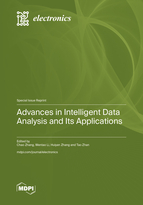Advances in Intelligent Data Analysis and Its Applications
A special issue of Electronics (ISSN 2079-9292). This special issue belongs to the section "Industrial Electronics".
Deadline for manuscript submissions: closed (30 September 2023) | Viewed by 32986
Special Issue Editors
Interests: data mining; granular computing; intelligent decision making
Special Issues, Collections and Topics in MDPI journals
Interests: data mining; cognitive computation; granular computing
Special Issues, Collections and Topics in MDPI journals
Interests: Markov jump systems; stochastic systems; event-triggered schemes; filtering design; controller design; cyber-attacks; time-delay; robust control
Special Issues, Collections and Topics in MDPI journals
Interests: data mining; machine learning
Special Issues, Collections and Topics in MDPI journals
Special Issue Information
Dear Colleagues,
With the rapid growth of cloud computing, the Internet of Things, and the industrial internet, various complicated data analysis tasks subsequently emerged in the development of social economy. Among the known problem-solving procedures of data analysis issues, one of the key challenges is how to manage, model, and process numerous acquired data. Thus, it is imperative to explore efficient models and methods for intelligent data analysis and applications. Currently, many scholars and practitioners have put forward a series of intelligent data analyses and applications from various perspectives, such as data mining, machine learning, natural language processing, granular computing, social networks, machine vision, cognitive computation, and other hybrid models. Aiming at numerous complicated data in the real world, investigating intelligent data analyses and applications are significant to diverse scenarios in the era of big data, so as to further enrich the community of computer science and engineering.
The goal of this Special Issue is to collect recent developments in the area of intelligent data analysis and how can they be applied to various real-world issues, such as finance, medical diagnosis, business intelligence, engineering, environmental science, etc. Original research work, significantly extended versions of conference papers, and review papers are welcome. Topics of interest include, but are not limited to, the following:
- Intelligent data mining algorithms and applications;
- Machine learning for intelligent data analysis;
- Natural language processing methods;
- Intelligent granular computing models;
- Intelligent data analysis in social networks;
- Machine vision-based data analysis;
- Hybrid models of cognitive computation and intelligent data analysis.
Dr. Chao Zhang
Dr. Wentao Li
Dr. Huiyan Zhang
Dr. Tao Zhan
Guest Editors
Manuscript Submission Information
Manuscripts should be submitted online at www.mdpi.com by registering and logging in to this website. Once you are registered, click here to go to the submission form. Manuscripts can be submitted until the deadline. All submissions that pass pre-check are peer-reviewed. Accepted papers will be published continuously in the journal (as soon as accepted) and will be listed together on the special issue website. Research articles, review articles as well as short communications are invited. For planned papers, a title and short abstract (about 100 words) can be sent to the Editorial Office for announcement on this website.
Submitted manuscripts should not have been published previously, nor be under consideration for publication elsewhere (except conference proceedings papers). All manuscripts are thoroughly refereed through a single-blind peer-review process. A guide for authors and other relevant information for submission of manuscripts is available on the Instructions for Authors page. Electronics is an international peer-reviewed open access semimonthly journal published by MDPI.
Please visit the Instructions for Authors page before submitting a manuscript. The Article Processing Charge (APC) for publication in this open access journal is 2400 CHF (Swiss Francs). Submitted papers should be well formatted and use good English. Authors may use MDPI's English editing service prior to publication or during author revisions.









